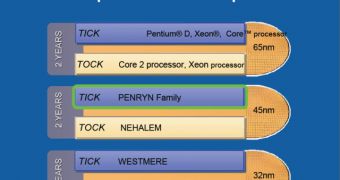AMD will soon launch its Barcelona quad core processors and Intel will follow after a few months with a new family of processors named Penryn. Based on the 45nm technological process, the processors using the Core 2 micro architecture and the quad core design are gathered into a single family generically named Penryn. This family will include the quad cored Xeon Harpertown and Core 2 Yorkfield as well as the dual cored Xeon and Core 2 Wolfdale processors, according to the news site DailyTech.
Operating at the same general clock speeds as the Conroe based processors, the CPUs from the Penryn family include several new technologies in order to receive a performance boost without increasing the speed. This is possible as Intel designed the micro architecture Conroe as an expandable one. Among the tweaks and improvements, Intel focused on the already existing Wide Dynamic Execution, Advanced Smart Cache, Advanced Digital Media Boost and Intelligent Power Capability technologies that were in use since the debut of the Conroe and Merom classes of CPUs. The Wide Dynamic Execution technology is now equipped with a faster radix-16 divider and some improvements to the core Virtualization technology as well that translates in the CPU's ability to process 4-bits per cycle instead of the 2-bits per cycle that are available to the Conroe class, while the improvements in VT technology make the virtual machines have lower transition times.
The Advanced Smart Cache technology is now backed up by an increased level two of cache memory as the Penryn based processors will come with as much as 12MB (quad core models) and 6MB (dual core versions) of cache that has a lower latency then of similar Conroe processors because of the 24-way associative cache used (as opposed to the older and slower 16-way associative cache). The SSE multimedia instructions family received a much needed update with the implementation of the SSE4 that is composed of 47 new instructions. The Advanced Digital Media Boost technology will benefit from the inclusion of the SSE4 instructions, as Intel claims a two times increase in the performance of the video acceleration tasks. Intel's Super Shuffle Engine, also a part of the Advanced Digital Media Boost technology, should allow grater performance to be achieved when dealing with unpacking, packing, align concatenated sources, wide shifts, insertion and extraction, and setup for horizontal arithmetic functions.
On the mobile market segment, the Penryn based processors are expected to shine because of their new power saving technologies that include a deep power down state, where the CPU lowers the core voltage and turns off both levels of cache memory.

 14 DAY TRIAL //
14 DAY TRIAL //